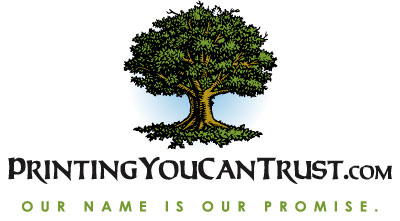Paper Options
The paper you use is a critical factor in the appearance of your printed projects. For most of our products, PrintingYouCanTrust.com has limited paper options to those most popular for the usage. However, for most products, we still offer a choice between a number of paper options. The information below is included to help you understand your alternatives.
About Papers
There are three factors that effect key differences between papers: finish, weight and opacity.
Finish
Finish refers to the texture, feel and appearance of a paper. Paper finishes are delineated as follows:
- Coated. A paper with a waxy finish (shiny or matte) on both sides.
- Uncoated. A paper with an untreated surface that is dull and unreflective.
- Coated One Side. A cover stock that is shiny on one side and dull on the reverse side.
- Wove. A smooth uncoated surface.
- Laid. A paper that is manufactured with textured lines on its surface. This finish is used mostly for business stationery elements, like letterhead, envelopes and business cards.
- Linen. Similar to a laid finish, this paper has textured lines on the surface of the sheet, but they are finer and more regular than those that appear on a laid finish stock. This paper is also used frequently for business stationery.
- Laser. A paper which is guaranteed to be compatible with laser printers.
Weight
The weight of a paper refers to its thickness and is measured in pounds. The higher the number, the thicker the paper. For paper weight, the “#” symbol means pounds.
Opacity
The opacity of paper is determined by its thickness, ingredients and ink absorbency. Opacity is important because it affects how much printing will show through on the reverse side of a sheet. If a paper is not opaque enough, images printed on the other side of the sheet may show through and make reading text impossible. Paper with a high degree of opacity is better able to prevent dark images from showing through a page. Opacity is expressed in terms of percentage reflectance. Complete opacity is 100% and complete transparency is 0%.
There are generally three types of papers for three distinct purposes: text papers, bond or writing papers and cover papers.
Text
Also known as book or offset papers, text paper can have a coated or uncoated finish. These thinner, lightweight papers are often used for publication interiors, sell sheets and letterheads. Below is a brief description of some of the most common text weights, from lightest to heaviest:
- 50# – Standard light weight paper, equivalent to 20# bond.
- 60# – One grade heavier than standard, equivalent to 24# bond.
- 70# – Equivalent to 28# bond.
- 80#
- 100#
Bond or Writing
Bond or writing papers are used for letterhead and must be able to run through office copy machines and laser printers. The most commonly recognized bond or writing stocks are:
- 20# – A standard weight paper, equivalent to 50# text.
- 24# – The preferred weight for most business papers like letterheads, equivalent to 60# text.
- 28# – Heavier paper less frequently used because its thickness can pose problems feeding through laser printers. However, the durability of this stock makes its ideal for outer envelopes.
Cover
Cover stocks are heavy in weight, rigid and not easily folded. These papers are generally used for publication covers, business cards and postcards. They can have coated or uncoated finishes. Common weights for cover stocks include:
- 65# – A lightweight, uncoated cover stock.
- 80# – The next weight heavier than 65#.
- 88# – Heavier than 80#, but still considered a lightweight cover paper.
- 100# – Mid-weight cover paper.
- 120# – Sturdy cover paper considered a heavyweight.
- 12 pt. – A heavyweight coated cover alternative.
Generally, glossy papers are used for brochures, product sheets, catalogs, posters, postcards and four-color business cards. Uncoated stock is best for letterhead, envelopes, business cards, newsletters and any document that needs to be fed through a laser printer.
Paper Descriptions
Following are the papers specifically offered for the standard printing products available from PrintingYouCanTrust.com.
- 80# and 100# gloss text
Standard glossy paper stock with a shiny finish that provides an excellent opaque base for rich process color printing. The most popular stocks for brochures, product sheets, flyers, posters, etc.
- 80# and 100# matte text
Finely coated, non-gloss finished paper with excellent opaque base for easy to read, crisp typography. This paper is often used for brochures, newsletters, book pages, flyers, etc.
- 80#, 100# and 120# gloss cover
Eye-catching, heavier glossy paper stock used for rack cards, business card and covers.
- 24#Strathmore Writing, Wove, Bright White
Strathmore writing is America’s most frequently specified 25% cotton business paper. Professionals choose cotton paper for is distinct feel and strength. Use this paper for letterhead and envelopes.
- 80# Cover, Strathmore Writing, Wove, Bright White
Match your letterhead and envelopes with the cover stock for your business cards.
- 60# Cougar Opaque offset white
Another alternative for stationery elements, Cougar has a long-standing reputation for high quality reproduction and excellent printability. Its superior opacity and extremely bright white color makes inks appear to jump off the page.
- 80# cover, Cougar Opaque white, smooth
Match your letterhead and envelopes with the cover stock for business cards.
- 24# and 28# White Wove
A standard commercial grade paper stock often used for envelopes. 24# is used for most envelopes, but 28# is used for larger envelopes and greater durability.
- 12 pt. C2S coated
A basic white, coated cover stock sturdy enough to stand up to the wear and tear of postcards.
Note: If you require a paper option not included on this list for your project, we can probably meet your needs—please send us a Custom Quote Request.


